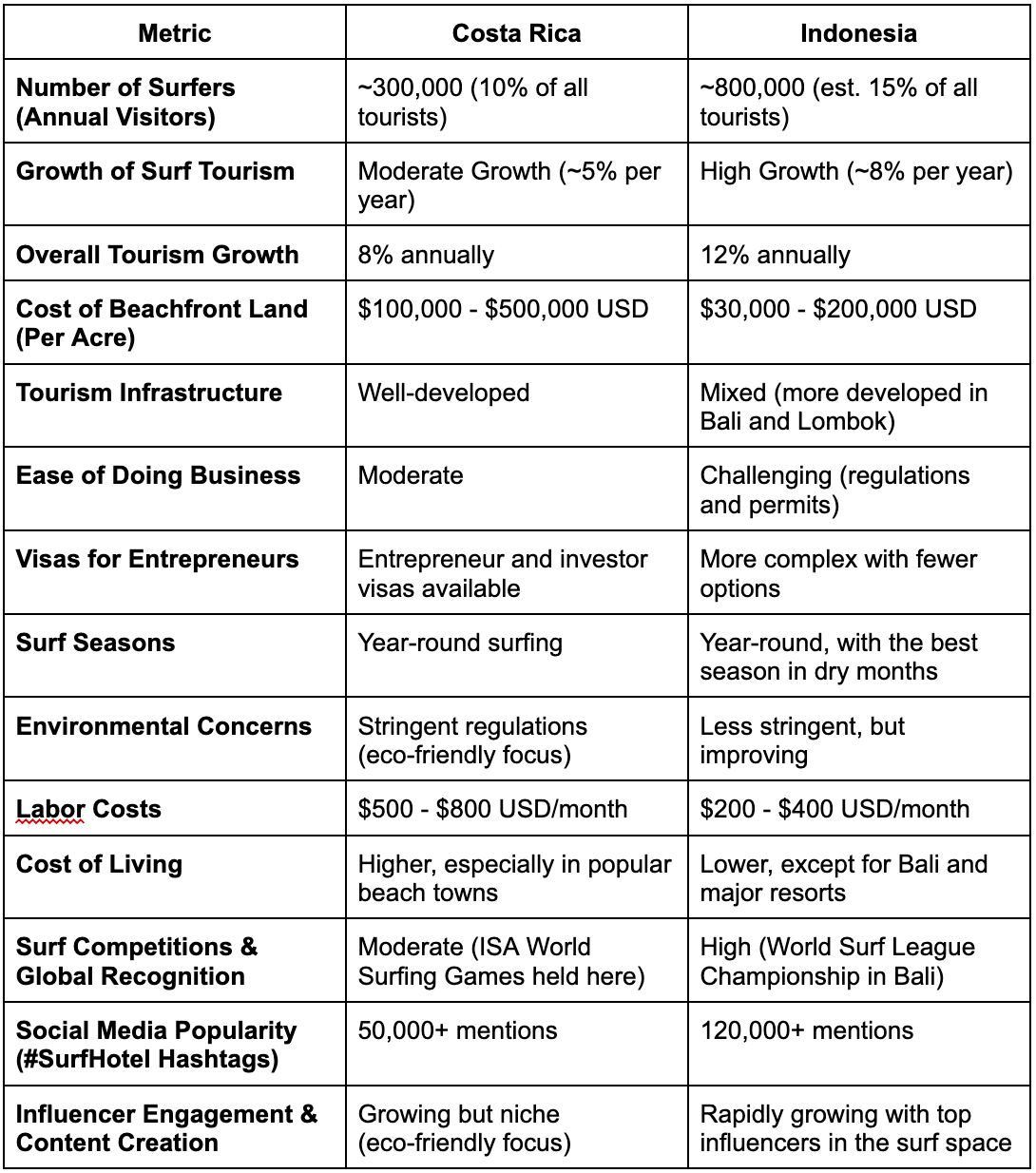Surf Market Comparison - Indonesia vs Costa Rica
Costa Rica's eco-friendly stability vs. Indonesia's booming growth and untapped potential
If you’ve ever dreamed of running a surf hotel in a tropical paradise, you’ve probably considered two of the most popular surf destinations in the world: Costa Rica and Indonesia. Both offer stunning beaches, epic waves, and tons of surf-loving tourists. But which is better for starting a surf hotel right now? Let's break it down by looking at some important factors: the number of surfers, land prices, tourism growth, and even social media buzz.
Let’s Dive In:
Number of Surfers & Tourism Growth:
Costa Rica brings in around 300,000 surfers annually, which is about 10% of all tourists. Surf tourism in Costa Rica is growing at a steady 5% each year, and it’s well-known for eco-friendly tourism. Spots like Tamarindo and Santa Teresa are already surf magnets, making it a solid, established market.
Indonesia is on another level when it comes to surfers. An estimated 800,000 surfers visit annually, making up around 15% of all tourists. With a 12% annual growth in tourism and surf tourism growing at an even faster pace (8% per year), Indonesia is a booming market. Bali, Lombok, and nearby islands are top-tier surfing destinations, with world-class waves and frequent international competitions.
Cost of Buying Land:
In Costa Rica, the cost of beachfront land is higher, ranging from $100,000 to $500,000 per acre, especially near surf hotspots. While the initial investment is significant, Costa Rica’s stable real estate market and eco-tourism appeal can offer long-term returns.
Indonesia provides more affordable options, with beachfront land prices ranging from $30,000 to $200,000 per acre in lesser-known areas like Sumbawa or West Java. Bali is pricier, but Indonesia still offers vast opportunities for those looking to invest in up-and-coming surf spots.
Ease of Doing Business:
Costa Rica offers a smoother path for foreign investors, with entrepreneur and investor visas readily available. Its business environment is relatively straightforward, although some bureaucracy can slow things down. The country’s strong focus on eco-tourism might make it easier for you to find support for sustainable surf hotel projects.
Indonesia is a bit trickier. The process for setting up a business, especially for foreigners, is more complex, with strict regulations around land ownership and permits. Bali and Lombok are more accessible, but other parts of Indonesia require patience and local connections to navigate the red tape.
Social Media & Content Creation:
Costa Rica has a growing online presence, especially when it comes to eco-friendly and sustainable tourism. #SurfHotel mentions for Costa Rica reach over 50,000 on Instagram, and the country is becoming increasingly popular among niche travel influencers who love highlighting its green practices. If your brand is focused on sustainability, Costa Rica is a great place to create content that resonates with conscious travelers.
Indonesia is a social media powerhouse. With over 120,000 #SurfHotel mentions, Bali and other surf spots in Indonesia are all over platforms like Instagram, TikTok, and YouTube. Many top surf influencers frequently feature Indonesian breaks, creating a ton of free content and marketing opportunities. Plus, the affordability of content creation in Indonesia allows for easier collaboration with local influencers and creatives.
Tourism Infrastructure:
Costa Rica is well-developed in terms of tourism infrastructure. From reliable roads to medical services, your guests will be well taken care of, even in more remote areas. Costa Rica is also big on eco-tourism, so expect to find a lot of support if your hotel emphasizes sustainability.
Indonesia is a mixed bag. Bali has world-class infrastructure for tourists, but if you’re eyeing other islands, expect to invest more in building amenities. That said, these less-developed areas also offer the greatest opportunity for growth, especially if you’re catering to adventure-seeking surfers who want to get off the beaten path.
Labor Costs and Operational Expenses:
Costa Rica has higher labor costs compared to Indonesia. Monthly wages for staff range between $500 and $800. It’s not cheap, especially in popular surf towns, where living costs can be relatively high.
Indonesia is significantly cheaper when it comes to labor and day-to-day operations. Staff wages are around $200 to $400 per month, depending on the location. This can make a huge difference when you're budgeting for your surf hotel and looking to keep operational costs down.
So, Where Should You Start Your Surf Hotel?
It really depends on your goals. Here’s the rundown:
Costa Rica: If you’re looking for stability, easy business operations, and a surf market that’s already established, Costa Rica is your place. It’s eco-friendly, has reliable infrastructure, and you can market to travelers looking for that laid-back, sustainable vibe.
Indonesia: If you’re looking for growth potential, lower costs, and don’t mind navigating some regulatory challenges, Indonesia has massive upside. The surf scene is booming, and social media presence is much stronger, giving you access to a younger, content-driven audience.
If you’re willing to take on a bit more risk for higher rewards, Indonesia is the better choice. But if you value a more streamlined process with a focus on sustainability, Costa Rica will make your surf hotel dreams come true



